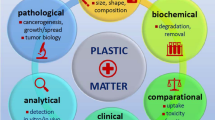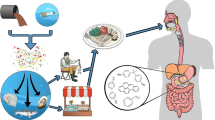Abstract
Additional occurrence data are needed to better understand human exposure to per- and poly-fluoroalkyl substances (PFAS) from commercially available foods in the United States. The Food and Drug Administration’s (FDA) Total Diet Study (TDS) collects foods that are both nationally and regionally distributed. In 2018, 172 processed foods were collected from grocery stores around Lenexa, KS, as part of the TDS national collection. A previously developed method for the analysis of PFAS in foods as part of the TDS regional collection was modified and optimized for these samples. This method was single lab validated using 5 different matrices and method detection limits were calculated. During the analysis of these samples, challenges arose with method blanks and further investigation into statistical methods to distinguish between blank and sample concentrations were done. The confirmation of two short chain PFAS, perfluorobutanoic acid (PFBA) and perfluoropentanoic acid (PFPeA), was not possible using triple quadrupole mass spectrometry and a confirmation method was developed using high-resolution mass spectrometry. This technique was also used to investigate potential detections and interferents that fell within the retention time criteria for positive detections. In the national collection, positive detections of perfluorooctanesulfonic acid (PFOS) and perfluorononanoic acid (PFNA) were found in frozen fish sticks/patties, PFOS and perfluorodecanoic acid (PFDA) in canned tuna, and PFOS in protein powder. Concentrations were all below 150 ppt, and no other detects were confirmed above the method detection limits in any other foods.
Graphical abstract





Similar content being viewed by others
References
Buck RC, Franklin J, Berger U, Conder JM, Cousins IT, de Voogt P, et al. Perfluoroalkyl and polyfluoroalkyl substances in the environment: terminology, classification, and origins. Integr Environ Assess Manag. 2011;7(4):513–41.
Kissa E. Fluorinated surfactants and repellents. 2nd ed. New York: Marcel Dekker; 2001.
Yamashita N, Kannan K, Taniyasu S, Horii Y, Petrick G, Gamo T. A global survey of perfluorinated acids in oceans. Mar Pollut Bull. 2005;51(8–12):658–68.
Giesy JP, Kannan K. Global distribution of perfluorooctane sulfonate in wildlife. Environ Sci Technol. 2001;35(7):1339–42.
Taniyasu S, Kannan K, Horii Y, Hanari N, Yamashita N. A survey of perfluorooctane sulfonate and related perfluorinated organic compounds in water, fish, birds, and humans from Japan. Environ Sci Technol. 2003;37(12):2634–9.
Hansen KJ, Clemen LA, Ellefson ME, Johnson HO. Compound-specific, quantitative characterization of organic fluorochemicals in biological matrices. Environ Sci Technol. 2001;35(4):766–70.
Kannan K, Corsolini S, Falandysz J, Fillmann G, Kumar KS, Loganathan BG, et al. Perfluorooctanesulfonate and related fluorochemicals in human blood from several countries. Environ Sci & Technol. 2004;38(17):4489–95.
Riddell N, Arsenault G, Benskin JP, Chittim B, Martin JW, McAlees A, et al. Branched perfluorooctane sulfonate isomer quantification and characterization in blood serum samples by HPLC/ESI-MS(/MS). Environ Sci Technol. 2009;43(20):7902–8.
Navarro I, de la Torre A, Sanz P, Porcel MÁ, Pro J, Carbonell G, et al. Uptake of perfluoroalkyl substances and halogenated flame retardants by crop plants grown in biosolids-amended soils. Environ Res. 2017;152:199–206.
Washington JW, Yoo H, Ellington JJ, Jenkins TM, Libelo EL. Concentrations, distribution, and persistence of perfluoroalkylates in sludge-applied soils near Decatur, Alabama, USA. Environ Sci Technol. 2010;44(22):8390–6.
Wen B, Wu Y, Zhang H, Liu Y, Hu X, Huang H, et al. The roles of protein and lipid in the accumulation and distribution of perfluorooctane sulfonate (PFOS) and perfluorooctanoate (PFOA) in plants grown in biosolids-amended soils. Environ Pollut. 2016;216:682–8.
Berger U, Glynn A, Holmström KE, Berglund M, Ankarberg EH, Törnkvist A. Fish consumption as a source of human exposure to perfluorinated alkyl substances in Sweden - analysis of edible fish from Lake Vättern and the Baltic Sea. Chemosphere. 2009;76(6):799–804.
Stahl LL, Snyder BD, Olsen AR, Kincaid TM, Wathen JB, McCarty HB. Perfluorinated compounds in fish from U.S. urban rivers and the Great Lakes. Sci Total Environ. 2014;499:185–95.
Schrenk D, Bignami M, Bodin L, Chipman JK, Del Mazo J, Grasl-Kraupp B, et al. Risk to human health related to the presence of perfluoroalkyl substances in food. EFSA J. 2018;18(9):e06223–e.
Tittlemier SA, Pepper K, Seymour C, Moisey J, Bronson R, Cao XL, et al. Dietary exposure of Canadians to perfluorinated carboxylates and perfluorooctane sulfonate via consumption of meat, fish, fast foods, and food items prepared in their packaging. J Agric Food Chem. 2007;55(8):3203–10.
Gebbink WA, Glynn A, Darnerud PO, Berger U. Perfluoroalkyl acids and their precursors in Swedish food: the relative importance of direct and indirect dietary exposure. Environ Pollut. 2015;198:108–15.
Domingo JL, Ericson-Jogsten I, Perelló G, Nadal M, Van Bavel B, Kärrman A. Human exposure to perfluorinated compounds in Catalonia, Spain: contribution of drinking water and fish and shellfish. J Agric Food Chem. 2012;60(17):4408–15.
Noorlander CW, van Leeuwen SPJ, te Biesebeek JD, Mengelers MJB, Zeilmaker MJ. Levels of perfluorinated compounds in food and dietary intake of PFOS and PFOA in The Netherlands. J Agric Food Chem. 2011;59(13):7496–505.
D’Hollander W, de Voogt P, de Coen W, Bervoets L. Perfluorinated substances in human food and other sources of human exposure. Rev Enviorn Contam Toxicol. 2010;208:179–215.
Hlouskova V, Hradkova P, Poustka J, Brambilla G, De Filipps SP, D’Hollander W, et al. Occurrence of perfluoroalkyl substances (PFASs) in various food items of animal origin collected in four European countries. Food Addit Contam, Part A. 2013;30(11):1918–32.
Guerranti C, Perra G, Corsolini S, Focardi SE. Pilot study on levels of perfluorooctane sulfonic acid (PFOS) and perfluorooctanoic acid (PFOA) in selected foodstuffs and human milk from Italy. Food Chem. 2013;140(1–2):197–203.
Pérez F, Llorca M, Köck-Schulmeyer M, Škrbić B, Oliveira LS, da Boit MK, et al. Assessment of perfluoroalkyl substances in food items at global scale. Environ Res. 2014;135:181–9.
Fair PA, Wolf B, White ND, Arnott SA, Kannan K, Karthikraj R, et al. Perfluoroalkyl substances (PFASs) in edible fish species from Charleston Harbor and tributaries, South Carolina, United States: exposure and risk assessment. Environ Res. 2019;171:266–77.
Furdui VI, Stock NL, Ellis DA, Butt CM, Whittle DM, Crozier PW, et al. Spatial distribution of perfluoroalkyl contaminants in lake trout from the Great Lakes. Environ Sci Technol. 2007;41(5):1554–9.
Sinclair E, Mayack DT, Roblee K, Yamashita N, Kannan K. Occurrence of perfluoroalkyl surfactants in water, fish, and birds from New York State. Arch Environ Contam Toxicol. 2006;50(3):398–410.
Scher DP, Kelly JE, Huset CA, Barry KM, Hoffbeck RW, Yingling VL, et al. Occurrence of perfluoroalkyl substances (PFAS) in garden produce at homes with a history of PFAS-contaminated drinking water. Chemosphere. 2018;196:548–55.
3M Company: analysis of PFOS, FOSA, and PFOA from various food matrices using HPLC electrospray mass spectrometry. June 21, 2001
Schecter A, Colacino J, Haffner D, Patel K, Opel M, Päpke O, et al. Perfluorinated compounds, polychlorinated biphenyls, and organochlorine pesticide contamination in composite food samples from Dallas, Texas, USA. Environ Health Perspect. 2010;118(6):796–802.
Young WM, South P, Begley TH, Noonan GO. Determination of perfluorochemicals in fish and shellfish using liquid chromatography–tandem mass spectrometry. J Agric Food Chem. 2013;61(46):11166–72.
Young WM, South P, Begley TH, Diachenko GW, Noonan GO. Determination of perfluorochemicals in cow’s milk using liquid chromatography-tandem mass spectrometry. J Agric Food Chem. 2012;60(7):1652–8.
Ruffle B, Vedagiri U, Bogdan D, Maier M, Schwach C, Murphy-Hagan C. Perfluoroalkyl substances in U.S. market basket fish and shellfish. Environ Res. 2020;190:109932.
Genualdi S, Young W, DeJager L, Begley T. Method development and validation of per- and polyfluoroalkyl substances in foods from FDA’s Total Diet Study Program. J Agric Food Chem. 2021;69(20):5599–606.
Total Diet Study Design Available from: https://www.fda.gov/food/total-diet-study/total-diet-study-design.
U.S. Department of Agriculture ARS, Beltsville Human Nutrition Research Center, Food Surveys Research Group (Beltsville, MD) and U.S. Department of Health and Human Services, Centers for Disease Control and Prevention, National Center for Health Statistics (Hyattsville, MD). What we Eat in America database Available from: https://data.nal.usda.gov/dataset/what-we-eat-america-wweia-database.
Genualdi, S.; Dejager, L. Determination of 16 perfluoroalkyl and polyfluoroalkyl substances (Pfas) in food using liquid chromatography-tandem mass spectrometry (LC-MS/MS). https://www.fda.gov/media/131510/download
Liberatore HK, Jackson SR, Strynar MJ, McCord JP. Solvent suitability for HFPO-DA (“GenX” parent acid) in toxicological studies. Environmental Science & Technology Letters. 2020;7(7):477–81.
Pierri A, Krepich S. Per-fluoroalkyl substances (PFAS) from butter using roQ QuEChERS and strata-X-AW solid phase extraction by LC-MS/MS 2017 Available from: https://phenomenex.blob.core.windows.net/documents/a9406d77-c88e-49cb-9347-81efd828fc25.pdf.
Pierri A, Krepich S. Per- and polyfluorinated alkyl substances (PFAS) from milk, eggs, butter, cheese, and fish using QuEChERS, SPE, and LC-MS/MS - phenomenex application note: TN-01234 2018 Available from: https://phenomenex.blob.core.windows.net/documents/a9406d77-c88e-49cb-9347-81efd828fc25.pdf.
Ullah S, Alsberg T, Berger U. Simultaneous determination of perfluoroalkyl phosphonates, carboxylates, and sulfonates in drinking water. J Chrom A. 2011;1218(37):6388–95.
Guidelines for the validation of chemical methods for the FDA FVM Program Washington, DC2015 [cited 2017 Mar 23]. Available from: https://www.fda.gov/downloads/ScienceResearch/FieldScience/UCM273418.pdf.
Benskin JP, Bataineh M, Martin JW. Simultaneous characterization of perfluoroalkyl carboxylate, sulfonate, and sulfonamide isomers by liquid chromatography−tandem mass spectrometry. Anal Chem. 2007;79(17):6455–64.
Carlos KS, de Jager LS, Begley TH. Determination of phthalate concentrations in paper-based fast food packaging available on the U.S. market. Food Addit Contam Part A Chem Anal Control Expo Risk Assess. 2021;38(3):501–12.
FDA Guidance for Industry 118 - Confirmation of Identity of Animal Drug Residues. Available from: http://www.fda.gov/downloads/AnimalVeterinary/GuidanceComplianceEnforcement/GuidanceforIndustry/ucm052658.pdf.
Commission Decision 2002/657/EC implementing Council Directive 96/23/EC concerning the performance of analytical methods and the interpretation of results. Off J Eur Communities.L221 (17.8.2002):8–36.
WADA Technical Document – TD2010IDCR identification criteria for qualitative assays incorporating column chromatography and mass spectrometry, Version 1.0. September 2010.
Method 8327 - Per- and polyfluoroalkyl substances (PFAS) using external standard calibration and multiple reaction monitoring (MRM) liquid chromatography tandem mass spectrometry (LC/MS/MS) [4/3/19]. Available from: https://www.epa.gov/hw-sw846/validated-test-method-8327-and-polyfluoroalkyl-substances-pfas-using-external-standard.
Screening, Determination and Confirmation of PFAS by UPLC-MS-MS [Available from: https://www.fsis.usda.gov/sites/default/files/media_file/2021-04/CLG-PFAS2.03.pdf.
FoodB Available from: https://www.foodb.ca/.
Falk S, Failing K, Georgii S, Brunn H, Stahl T. Tissue specific uptake and elimination of perfluoroalkyl acids (PFAAs) in adult rainbow trout (Oncorhynchus mykiss) after dietary exposure. Chemosphere. 2015;129:150–6.
Goeritz I, Falk S, Stahl T, Schäfers C, Schlechtriem C. Biomagnification and tissue distribution of perfluoroalkyl substances (PFASs) in market-size rainbow trout (Oncorhynchus mykiss). Environ Toxicol Chem. 2013;32(9):2078–88.
Author information
Authors and Affiliations
Corresponding author
Ethics declarations
Competing interests
The authors declare no competing interests.
Additional information
Published in the topical collection Per- and Polyfluoroalkyl Substances (PFAS) – Contaminants of Emerging Concern with guest editors Erin Baker and Detlef Knappe.
Publisher’s note
Springer Nature remains neutral with regard to jurisdictional claims in published maps and institutional affiliations.
Supplementary information
ESM 1
(DOCX 1428 kb)
Rights and permissions
About this article
Cite this article
Genualdi, S., Beekman, J., Carlos, K. et al. Analysis of per- and poly-fluoroalkyl substances (PFAS) in processed foods from FDA’s Total Diet Study. Anal Bioanal Chem 414, 1189–1199 (2022). https://doi.org/10.1007/s00216-021-03610-2
Received:
Revised:
Accepted:
Published:
Issue Date:
DOI: https://doi.org/10.1007/s00216-021-03610-2




